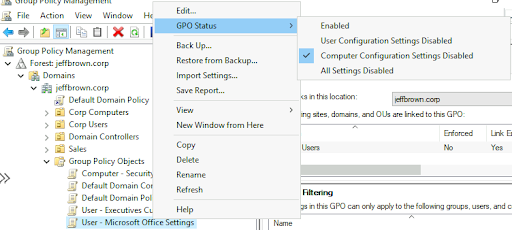As the backbone of centralized management in Windows environments, Group Policies play a crucial role in maintaining security, enforcing settings, and ensuring consistency across an organization’s Active Directory infrastructure. However, effectively managing Group Policies can be a complex and daunting task for administrators. The intricate web of policies, organizational units, inheritance rules, and potential conflicts requires a systematic approach to ensure smooth operations and minimize disruptions. In this article, we will delve into the best practices for managing Group Policies in Active Directory, providing valuable insights and practical tips to help administrators navigate this critical aspect of IT infrastructure management.
Whether you’re an experienced IT professional looking to refine your skills or a newcomer seeking guidance on proper policy management techniques, this article aims to unravel the complexities surrounding Group Policies in Active Directory. From avoiding common pitfalls to optimizing performance and scalability, we’ll explore proven strategies that can streamline policy deployment while maintaining compliance with security standards and regulatory requirements. Join us as we uncover the best practices for managing Group Policies in Active Directory and empower your organization with efficient policy administration.
What are the best practices for managing Group Policies in Active Directory?
Managing Group Policies in Active Directory (AD) is crucial for enforcing security settings, configurations, and restrictions across an organization’s network. Here are some best practices for effectively managing Group Policies in Active Directory:
- Organize Group Policies
- Use Inheritance Wisely
- Avoid Overuse of Block Inheritance and Enforced Settings
- Document Group Policy Objects (GPO’s)
- Naming Conventions
- Security Filtering
- WMI Filtering
- Regularly Review and Update Group Policies
- Test Policies in a Lab Environment
- Delegate Administration
- Backup Group Policy Objects
- Utilize Group Policy Inheritance Modeling and Results
- Keep Policies Simple and Specific
- Monitor and Audit Group Policy Changes
- Stay informed about updates.
1. Organize Group Policies:
Use a logical and organized structure for organizing Group Policies. Consider creating separate OUs (Organizational Units) for different departments, teams, or types of systems to help streamline management.
2. Use Inheritance Wisely:
Leverage the hierarchical structure of Active Directory to allow for policy inheritance. Understand how policies are inherited from parent to child OUs and adjust settings accordingly.
3. Avoid Overuse of Block Inheritance and Enforced Settings:
While you can use features like “Block Inheritance” and “Enforced” (formerly known as “No Override”), use them judiciously. Overuse can make the system complex and challenging to manage.
4. Document Group Policy Objects (GPOs):
Clearly document the purpose and settings of each Group Policy Object (GPO). This documentation is essential for understanding the impact of changes and for troubleshooting.
5. Naming Conventions:
Establish a clear and consistent naming convention for GPOs. This helps in easily identifying the purpose of each policy and its intended scope.
6. Security Filtering:
Use security filtering to apply Group Policies to specific security groups or individual users. This allows for more granular control over which users and computers receive specific policies.
7. WMI Filtering:
Consider using Windows Management Instrumentation (WMI) filtering to further refine the scope of Group Policies based on specific conditions, such as hardware characteristics or system attributes.
8. Regularly Review and Update Group Policies:
Periodically review and update Group Policies to ensure they align with the organization’s changing needs, security requirements, and compliance standards.
9. Test Policies in a Lab Environment:
Before deploying new or modified Group Policies to the production environment, test them in a lab or test environment to identify any unintended consequences.
10. Delegate Administration:
Delegate Group Policy administration to appropriate IT staff members. This allows different teams or individuals to manage policies for specific OUs without granting unnecessary permissions.
11. Backup Group Policy Objects:
Regularly back up Group Policy Objects to ensure that you can quickly recover in case of accidental changes or deletions. Use the Group Policy Management Console (GPMC) to export and import policies.
12. Utilize Group Policy Inheritance Modeling and Results:
Use tools like Group Policy Modeling and Group Policy Results to simulate and analyze how policies are applied in different scenarios. This helps in understanding the effective policies for a specific user or computer.
13. Keep Policies Simple and Specific:
Avoid creating overly complex or broad policies. Keep policies simple, specific, and focused on the intended purpose to reduce the likelihood of unintended consequences.
14. Monitor and Audit Group Policy Changes:
Enable auditing for Group Policy changes to track modifications. Regularly review audit logs to ensure that changes are authorized and align with security policies.
15. Stay Informed About Updates:
Stay informed about updates and changes to Group Policy settings with each new version of Windows Server. Microsoft periodically introduces new policies and security settings that may be relevant to your organization.
Conclusion:
Managing Group Policies in Active Directory requires a strategic and methodical approach to ensure the smooth functioning of an organization’s IT environment. By following best practices such as proper planning, regular testing, documentation, and version control, administrators can effectively streamline the deployment and management of Group Policies. Additionally, maintaining a clean and organized Group Policy structure will help minimize complexity and potential conflicts. Furthermore, continuous monitoring and evaluation of Group Policies is essential for identifying and addressing any issues or inconsistencies. Overall, adhering to these best practices will ultimately contribute to a more efficient and secure Active Directory environment.
We encourage IT administrators to implement these best practices in their organizations to optimize the management of Group Policies in Active Directory.






